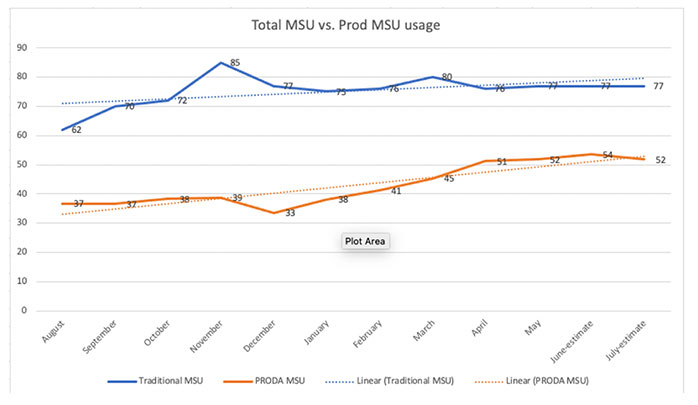Partner Development Executive
In the last year, organizations have seen a dramatic change in their need for supporting business applications. The availability demand has grown beyond the traditional infrastructure investments of the on-premises data center to include a hybrid-cloud deployment as well as a greater of emphasis on the high availability data center option. Workloads and workload execution timing is far less predictable in today’s mobile connected world.
Mainframe Software Licensing
Mainframe software licensing has always been a challenge to understand. Do you own the software, do you rent the software, what is the operational expense (OPEX) versus the capital expense (CAPEX) of the software, how much do your business applications really utilize the software?
Traditionally, mainframe software vendors provide the organization with the Operating software and related support based on a monthly charge, and these charges are often rolled into a lease structure. The cost model for Business Application software has been a bit different: These charges were structured as a two-component cost or expense. The first portion was the license entitlement – a perpetual license. A perpetual license was the upfront purchase of the software entitlement and it was viewed as the ownership of the software. The second portion was the maintenance and support portion of the software. This entitled the organization to break-fix questioning and support, as well as access to fix updates and enhancements during the term of the support contract. The perpetual license was seen as CAPEX and the maintenance support portion was viewed as OPEX.
Lowering Monthly Costs
The challenge was that the software was licensed on the total size of the mainframe and its capability to execute workloads. Many times, this was termed as being entitled at the full size of the mainframe or full capacity. As the mainframe usage decreased over the years and workloads were being moved to a Cloud or Hybrid-Cloud environment, organizations were wanting to pay for what they used or only be charged for what they were using. Software companies allowed for this type of pricing metric which was called Sub-Capacity Pricing.
In the sub-capacity pricing scenario, monthly reporting was submitted and based on the 4-hour rolling average (4HRA) of z/OS (the IBM mainframe operating system) and the organization was charged for only that sub-capacity amount. As it was quickly discovered, if the workloads could be governed or capped then the 4-hour rolling average could be reduced and therefore, the organization could achieve monthly cost savings. The challenge then transitioned into organizations spending many hours determining how to govern the workloads or stretch the workloads out over time. Capping a business application workload so that it ran a bit longer may produce a financial payback to the organization. Workload performance could be analyzed, and predictive rules and models were developed and tuned on a daily basis.
Over time, IT organizations were tasked with managing to the monthly cost of the software. Business applications were being throttled and financial governors were put in place. Business end-users, and ultimately customer experiences, were only as good as the last time they used the application or mobile interface. A greater challenge evolved with the growth explosion of the digital economy. There is no longer a correlation to normal business hours. Customers are utilizing mobile applications 24×7 and workload demands are no longer predictable. Mainframe and application resources need to be highly available and be able to scale up and down at a moment’s notice.
Mainframe Consumption Licensing (MCL)
IT executives soon began seeking software license pricing capability that provided for flexibility and predictability of software costs based on the consumption of mainframe z/OS systems.
Broadcom introduced a consumption licensing offering that does exactly what IT executives were seeking and it delivers a way to grow their mainframe z/OS investment. Released in May 2019, the Mainframe Consumption Licensing (MCL) model gives mainframe customers better visibility and predictability into their software spending while enabling them to maximize the value created for their end users.
Broadcom’s MCL model is a licensing model designed to support modern, dynamic, and changing mainframe workloads by offering:
- Consumption-based Licensing: Execute mainframe workloads when it matters most to enterprise needs, avoiding economic impacts from spiking 4HRA.
- Unlimited Dev/Test Support: Robust Dev/Test systems are required for modern, mission critical workloads but for customers licensing IBM development and test container solutions, Broadcom’s MCL model will exclude dev and test utilization from MCL utilization.
- Flexibility: Utilization below baseline can be rolled over to next true-up period – like roll-over minutes – providing customers with additional flexibility to manage growth and unexpected events within the term of their contract.
With MCL, you now can have a cloud-like pricing framework that aligns to your business demands. Working with Broadcom, you decide on a consumption baseline of MSUs for a given time period using SCRT analysis reporting. Any usage above your baseline is subject to a pre-defined pricing plan at the start. Simple and transparent.
How MCL Can Work in Your Environment
Step 1: Create a baseline
Create a baseline from a minimum of 3 months – 12 months of historical SCRT reports. Through analysis of the reports in the IBM SCRT N7 sections, the baseline MSU Hours monthly and calendar usage is determined. In addition, there is a consideration for organic growth of MSU hours over the term of the agreement.

Step 2: Consumption hours annualized
Summarize the MSU Hours for the production only LPARs versus the total usage of the mainframe. In the above N7 SCRT example only the Production LPAR regions are calculated as part of the monthly usage. No longer are Test/Dev or sandbox environments part of the monthly charges. In addition, workloads are not dependent on a single data center location. Workloads can move around data centers as needed.

Step 3: Program Flexibility
Broadcom has added the flexibility to overcome resource underutilization by rolling over unused MSUs to the next true-up period. Similar to cellular phone plans, unused MSU’s roll over to the next period for consumption within the contract term.

The Broadcom Mainframe Consumption License (MCL) Program is designed for customers who are maintaining or growing their software needs. With this pricing model, customers no longer need to manage workloads to a pricing metric and penalize the business application users.
Organizations benefit by:
- Simplified terms and conditions have been created to support the programs flexibility and requirements for participating customers;
- Summary pricing, predictable financial cost, and capacity established for the full licensed stack over the term of the agreement;
- With defined utilization fees for overages, the MSU/hour fee provides for an exact cost of expanding the business workload;
- In addition, annual true-up against contractual baseline provides for unused workload MSU hours to be rolled over to the immediate next calendar year as needed.
More Information
Mainline is a Broadcom Strategic partner, the highest level in the Broadcom partner program. Together we deliver business solutions to our mainframe customers, helping them to modernize their mainframe platforms, improve ROI and unlock business value. Read more about our partnership.
To learn more about how we may assist you in ensuring that your mainframe financial investment is up to date, please reach out to your Mainline Account Executive directly, or click here to contact us with questions.
Understanding more about Mainframe Software Licensing
BLOG: Software Licensing on IBM Z System: Part 1, Monthly License Charge Software
BLOG: International Program License Agreement IBM System z – Part 2
BLOG: Software Licensing on System z – Passport Advantage – Part 3

